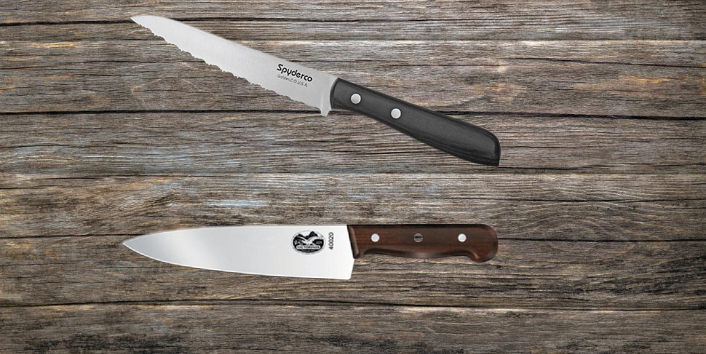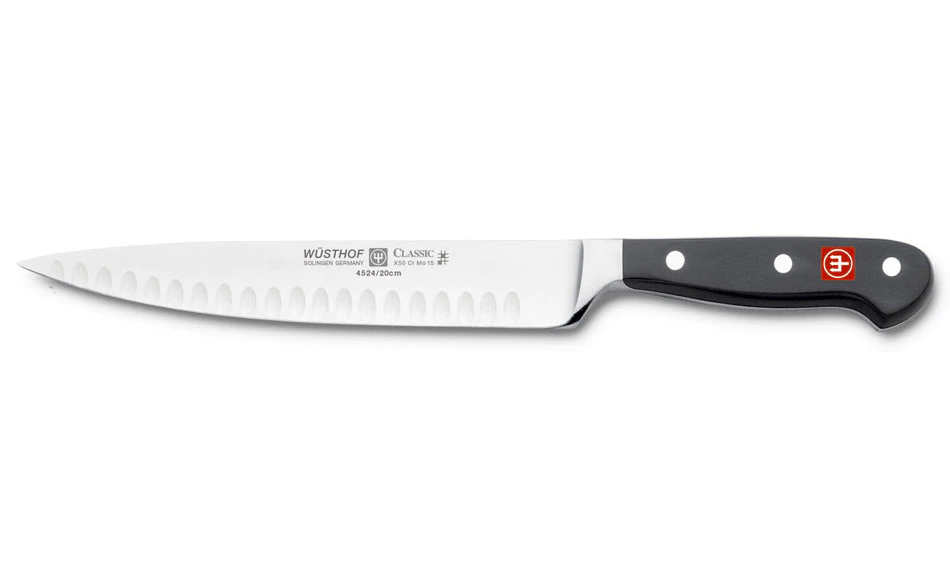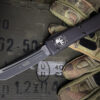Serrated Vs Plain Edge Kitchen Knives which is better? Almost 99% of partially-serrated and serrated kitchen knives are ground the same way. The major differences between these two kinds of knives are their lengths and grinds. Serrated knives are typically longer than their plain edge counterparts, but they still sacrifice length for greater precision.
Here are some pros and cons of each. Read on to find out which one you should get. This article will give you the information you need to make an informed decision on the serrated vs plain edge kitchen knives debate.

Hollow ground
A basic knowledge of knife edges can make a big difference when cooking. There are dozens of different styles and functions for knives, including hollow ground, serrated, and plain edge. Wusthof, a German knife manufacturer since 1814, offers hundreds of different knives with different edge shapes and styles.
Wusthof knives are commonly available at a range of retail stores and online. Serrated and plain edge knives are the most common types of kitchen knives.
Hollow-ground edges are made with concave primary bevels. They have a thin support near the edge, which makes them very sharp. The downside of hollow ground knives is that they need more sharpening than other kinds of kitchen knives. However, this grind is generally more durable and is an affordable option for many kitchens. Hollow ground knives are often found on lower-cost production knives, and can be sufficient for many tasks.

Pros
Serrated vs. plain edge kitchen knives: which one’s better? The debate on which type is better dates back to long before the internet was even around. Serrated knives are more efficient and have more versatility, while plain edge blades can be less friendly to new users. However, both types of blades are effective at different tasks. However, plain edge knives are more suited for most tasks.
The basic difference between the two is the edge. A serrated knife is thinner than a plain one, but it is more likely to rip the object you’re slicing or chopping. However, a plain edge can still perform well for most people. Sharpening a plain edge is more difficult than sharpening a serrated blade. If you’re in doubt, you should purchase a serrated knife.
99% of partially-serrated knives are ground exactly the opposite way
When choosing a knife, make sure you look at the serrations. A partially-serrated blade is one with a rip-inaccurate serration. Serrations on the blade’s belly are for cutting, and serrations on the handle area are for control. While the plain edge on a partially-serrated knife may be a bit less convenient, it’s still effective for most people.
You can also check the edge of a knife by using it to slice a tomato or piece of paper. A dull blade will require more effort to cut, and the blade may slip. To check the edge of your knife, use paper or a cutting board made from tomato skin. If it cuts through the paper smoothly, it’s sharp enough. Wood or polyethylene cutting boards will create less resistance to the blade edge.
Time-saving: Serrated Vs Plain Edge Kitchen Knives
Whether you’re choosing an EDC knife or a specialized kitchen tool, it’s important to understand the difference between serrated and plain edge knives. Both have their benefits and drawbacks. Serrated edge knives are typically sharper than their plain edge counterparts, but they both require sharpening. Serrated knives are also easier to use when cutting rough materials. Luckily, most knives come with both types of edges.
Serrated knives are ideal for cutting bread and fruit. In contrast, plain edge knives are best for cutting wood. While serrated knives can be sharper than plain edge knives, you’ll need to remember to use a pointed blade. Serrated knives have a wider, sturdier edge. This makes them more effective for cutting through wood. A serrated blade can also be more precise, allowing you to get clean cuts.
Friction reducer
Serrated knives have deeper serrations than plain-edge knives, and the force exerted by the user is split between the tips of the blade. More serrations mean less power per tip, but the edges of the serrated knives are much easier to bit into food. On the other hand, blades with narrower serrations tend to bite deeper into food.

Whether you choose serrated or plain edge kitchen knives depends on your preferences and the tasks you perform on a regular basis.
Both styles are sharpened along the edge. Generally, you should do this every few weeks, but if you sharpen your knife regularly, the serrated edge is more likely to stay sharper for a longer time. Besides, micro-bevels are easier to maintain. You should make at least five light passes across the blade to keep it sharp. Mirror edges require little grit progressions, but you must pay attention to the middle ones, which remove deeper scratches. These stones are 800, 1000, and fifteen hundred grit.
The post Serrated Vs Plain Edge Kitchen Knives appeared first on KnifeGenie.com.
Serrated Vs Plain Edge Kitchen Knives which is better? Almost 99% of partially-serrated and serrated kitchen knives are ground the same way. The major differences between these two kinds of knives are their lengths and grinds. Serrated knives are typically longer than their plain edge counterparts, but they still sacrifice length for greater precision.
Here are some pros and cons of each. Read on to find out which one you should get. This article will give you the information you need to make an informed decision on the serrated vs plain edge kitchen knives debate.

Hollow ground
A basic knowledge of knife edges can make a big difference when cooking. There are dozens of different styles and functions for knives, including hollow ground, serrated, and plain edge. Wusthof, a German knife manufacturer since 1814, offers hundreds of different knives with different edge shapes and styles.
Wusthof knives are commonly available at a range of retail stores and online. Serrated and plain edge knives are the most common types of kitchen knives.
Hollow-ground edges are made with concave primary bevels. They have a thin support near the edge, which makes them very sharp. The downside of hollow ground knives is that they need more sharpening than other kinds of kitchen knives. However, this grind is generally more durable and is an affordable option for many kitchens. Hollow ground knives are often found on lower-cost production knives, and can be sufficient for many tasks.

Pros
Serrated vs. plain edge kitchen knives: which one’s better? The debate on which type is better dates back to long before the internet was even around. Serrated knives are more efficient and have more versatility, while plain edge blades can be less friendly to new users. However, both types of blades are effective at different tasks. However, plain edge knives are more suited for most tasks.
The basic difference between the two is the edge. A serrated knife is thinner than a plain one, but it is more likely to rip the object you’re slicing or chopping. However, a plain edge can still perform well for most people. Sharpening a plain edge is more difficult than sharpening a serrated blade. If you’re in doubt, you should purchase a serrated knife.
99% of partially-serrated knives are ground exactly the opposite way
When choosing a knife, make sure you look at the serrations. A partially-serrated blade is one with a rip-inaccurate serration. Serrations on the blade’s belly are for cutting, and serrations on the handle area are for control. While the plain edge on a partially-serrated knife may be a bit less convenient, it’s still effective for most people.
You can also check the edge of a knife by using it to slice a tomato or piece of paper. A dull blade will require more effort to cut, and the blade may slip. To check the edge of your knife, use paper or a cutting board made from tomato skin. If it cuts through the paper smoothly, it’s sharp enough. Wood or polyethylene cutting boards will create less resistance to the blade edge.
Time-saving: Serrated Vs Plain Edge Kitchen Knives
Whether you’re choosing an EDC knife or a specialized kitchen tool, it’s important to understand the difference between serrated and plain edge knives. Both have their benefits and drawbacks. Serrated edge knives are typically sharper than their plain edge counterparts, but they both require sharpening. Serrated knives are also easier to use when cutting rough materials. Luckily, most knives come with both types of edges.
Serrated knives are ideal for cutting bread and fruit. In contrast, plain edge knives are best for cutting wood. While serrated knives can be sharper than plain edge knives, you’ll need to remember to use a pointed blade. Serrated knives have a wider, sturdier edge. This makes them more effective for cutting through wood. A serrated blade can also be more precise, allowing you to get clean cuts.
Friction reducer
Serrated knives have deeper serrations than plain-edge knives, and the force exerted by the user is split between the tips of the blade. More serrations mean less power per tip, but the edges of the serrated knives are much easier to bit into food. On the other hand, blades with narrower serrations tend to bite deeper into food.

Whether you choose serrated or plain edge kitchen knives depends on your preferences and the tasks you perform on a regular basis.
Both styles are sharpened along the edge. Generally, you should do this every few weeks, but if you sharpen your knife regularly, the serrated edge is more likely to stay sharper for a longer time. Besides, micro-bevels are easier to maintain. You should make at least five light passes across the blade to keep it sharp. Mirror edges require little grit progressions, but you must pay attention to the middle ones, which remove deeper scratches. These stones are 800, 1000, and fifteen hundred grit.
![]()

